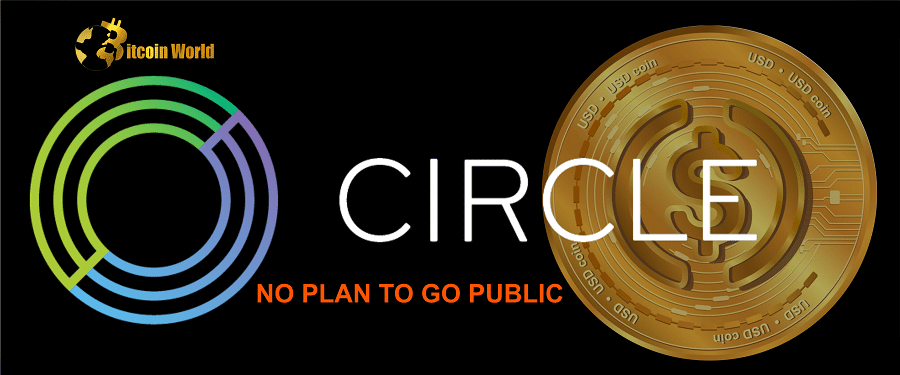In a surprising turn of events, Circle, the powerhouse behind the popular USDC stablecoin, has called off its plans to go public. The anticipated SPAC merger with Concord Acquisition Corp. is now off the table, leaving the crypto world wondering what’s next for this major player. Let’s dive into what we know about this unexpected development and what it could mean for the future of Circle and the broader cryptocurrency landscape.
Circle and Concord Part Ways: What Happened?
The news broke that Circle and Concord Acquisition Corp. have decided to terminate their agreement to merge. This merger was intended to take Circle public, allowing it to trade on the stock market. While both companies have remained tight-lipped about the exact reasons for the cancellation, a press release from Circle mentioned that the decision was made after “careful review and approval by both boards of directors.”
To put this in perspective, let’s quickly understand what a SPAC merger is:
- SPAC Explained: A Special Purpose Acquisition Company (SPAC) is essentially a blank-check company. It’s created solely to raise capital through an IPO with the purpose of acquiring an existing private company. This offers a quicker route for private companies to become publicly traded compared to a traditional Initial Public Offering (IPO).
- The Circle-Concord Deal: Circle initially announced its plans to merge with Concord in July 2021. This agreement was later revised in February 2022, doubling Circle’s valuation from $4.5 billion to a staggering $9 billion.
- Sudden Halt: Despite the revised agreement and anticipation, the merger has now been scrapped. This sudden termination has sparked discussions and speculations across the financial and crypto sectors.
Why Did the SPAC Merger Fall Apart? Unpacking the Potential Reasons
Neither Circle nor Concord has explicitly stated the reason for abandoning the merger. However, we can consider a few potential factors that might have contributed to this decision:
- Market Volatility: The cryptocurrency market has experienced significant volatility in 2022. This turbulence could have made both parties reconsider the timing and valuation of the public listing. Uncertain market conditions often lead to investors becoming more risk-averse, potentially impacting the attractiveness of SPAC deals.
- Changing Financial Landscape: The broader economic climate has shifted since the initial agreement. Rising interest rates and inflation concerns have affected investor sentiment and the appetite for growth stocks, including those in the crypto space.
- Regulatory Uncertainty: The regulatory landscape for cryptocurrencies is still evolving. Uncertainty surrounding regulations could have added complexity and risk to the public listing process, potentially leading to the decision to withdraw.
- Valuation Discrepancies: Although the valuation was revised upwards, there might have been disagreements or concerns about the $9 billion valuation in the current market environment, leading one or both parties to reconsider the terms.
Circle’s Strong Performance: A Silver Lining?
Despite the setback with the SPAC merger, Circle’s CEO, Jeremy Allaire, has emphasized the company’s strong performance. In a tweet, Allaire highlighted Circle’s “positive momentum” in Q3 2022, with estimated total sales of $274 million and net income of $43 million. He also pointed out the company’s robust cash reserves of nearly $400 million.
This financial strength suggests that while the SPAC route is no longer pursued, Circle remains in a healthy position. Here’s a quick look at Circle’s recent financial highlights based on reports:
| Financial Metric | Q3 2022 (Estimated) |
|---|---|
| Total Sales | $274 Million |
| Net Income | $43 Million |
| Cash Reserves | ~$400 Million |
This solid financial footing could provide Circle with the flexibility to explore alternative paths to becoming a publicly-traded company.
What’s Next for Circle’s Public Listing Ambitions?
The good news for those interested in Circle becoming a public entity is that the company hasn’t entirely abandoned the idea. Circle stated in its press release that it “will continue to explore alternative avenues to becoming a publicly-traded company.”
This indicates that Circle is still keen on accessing public markets, potentially through a traditional IPO or another strategic approach in the future. For now, Circle remains focused on its core mission: “building the infrastructure and services to enable the global cryptocurrency economy.”
Adding to their financial strength, Circle announced a significant $400 million funding round in April, backed by prominent investors like BlackRock, Fidelity, and Fin Capital. This Series E round valued the company at $3 billion, demonstrating continued investor confidence in Circle’s vision and potential.
In Conclusion: Navigating the Path Ahead
Circle’s decision to step away from the SPAC merger marks a significant moment for the company and the crypto industry. While the immediate path to becoming a public company has been disrupted, Circle’s underlying strength, financial performance, and commitment to the crypto space remain unwavering.
The reasons behind the failed merger are still speculative, but likely involve a combination of market conditions and strategic considerations. However, with a strong balance sheet and continued investor interest, Circle is well-positioned to explore new avenues for growth and potentially revisit its public listing ambitions when the time is right.
For now, the focus remains on Circle’s role as a key infrastructure provider in the burgeoning cryptocurrency economy, particularly through its widely adopted USDC stablecoin. The journey to becoming a public company might have taken an unexpected detour, but Circle’s destination remains firmly set on shaping the future of digital finance.
Disclaimer: The information provided is not trading advice, Bitcoinworld.co.in holds no liability for any investments made based on the information provided on this page. We strongly recommend independent research and/or consultation with a qualified professional before making any investment decisions.


